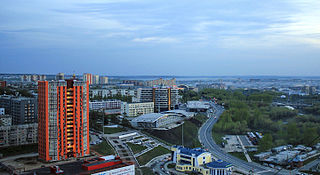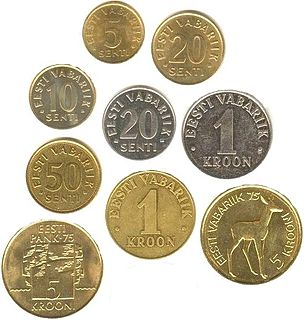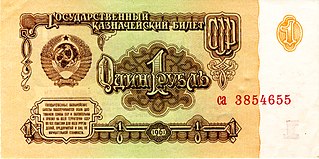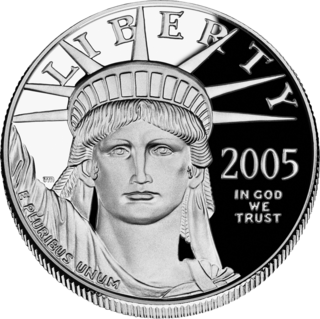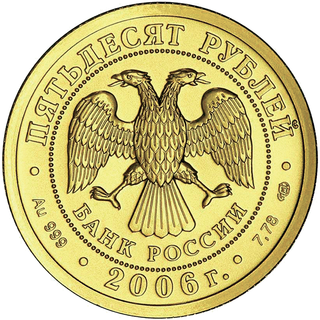Coins
| Series: The Age of Enlightenment. 18th Century. Battle of Chesma | |||||||||
|---|---|---|---|---|---|---|---|---|---|
| Date | Catalogue # | Value | Grading | Purity | Total weight, g | Platinum contents, at least, g | Diameter, mm | Thickness, mm | # pcs. |
| 24 November 1992 | 5318-0001 | 150 rubles | Proof | 999/1000 | 15.67 (± 0.11) | 15.55 | 28.60 (−0.25) | 1.5 (± 0.2) | 3000 |
| Obverse: two-headed eagle (designed by I. Bilibin), bottom – BANK OF RUSSIA. At the bottom – the designation of metal, alloy, the precious metal content and the mint trademark. Reverse: three sailing ships and a boat at the Battle of Chesma, around: "Age of Enlightenment. 18th century.", bottom: "Battle of Chesma" Design: A.V. Baklanov Mint: Leningrad Mint (LMD). 240 indents on the rim. [3] |  | ||||||||
| Series: The Olympic Century Russia. First participation of Russia in the Olympics | |||||||||
| Date | Catalogue # | Value | Grading | Purity | Total weight, g | Platinum contents, at least, g | Diameter, mm | Thickness, mm | # pcs. |
| 20 January 1993 | 5316-0001 | 50 rubles | Proof | 999/1000 | 7.88 (± 0.09) | 7.78 | 20.0 (−0.15) | 1.60 (± 0.15) | 7500 |
| Obverse: center – the emblem of the Bank of Russia (two-headed eagle designed by I. Bilibin), bottom – symbol, purity and weight of platinum, "BANK OF RUSSIA" Reverse: two horse riders – Russian participants of the II Olympic Games, right – the Eiffel Tower, left – the emblem of the Russian Olympic Committee, around: "OLYMPIC AGE OF RUSSIA, FIRST PARTICIPANCE · PARIS" Design: A.V. Baklanov (obverse), N.A. Nosov (reverse) Mint: Leningrad Mint (LMD). 134 indents on the rim. [4] | 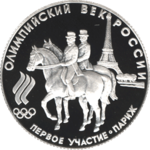 | ||||||||
| Series: Russian Ballet (25 rubles) | |||||||||
| Date | Catalogue # | Value | Grading | Purity | Total weight, g | Platinum contents, at least, g | Diameter, mm | Thickness, mm | # pcs. |
| 19 April 1993 | 5315-0001 | 25 rubles | Proof | 999/1000 | 3.198 (± 0.08) | 3.11 | 16.0 (−0.1) | 1.00 (± 0.15) | 750 |
| Obverse: center – the emblem of the Bank of Russia (two-headed eagle designed by I. Bilibin), bottom – symbol, purity and weight of platinum, "BANK OF RUSSIA" Reverse: a dancing ballerina, around it: "RUSSIAN BALLET" Design: A.V. Baklanov Mint: Leningrad Mint (LMD). 111 indents on the rim. [5] |  | ||||||||
| Series: Russian Ballet (50 rubles) | |||||||||
| Date | Catalogue # | Value | Grading | Purity | Total weight, g | Platinum contents, at least, g | Diameter, mm | Thickness, mm | # pcs. |
| 19 April 1993 | 5316-0002 | 50 rubles | Proof | 999/1000 | 7.88 (± 0.09) | 7.78 | 20.0 (−0.15) | 1.60 (± 0.15) | 750 |
| Obverse: center – the emblem of the Bank of Russia (two-headed eagle designed by I. Bilibin), bottom – symbol, purity and weight of platinum, "BANK OF RUSSIA" Reverse: a dancing ballerina, around it: "RUSSIAN BALLET" Design: A.V. Baklanov Mint: Leningrad Mint (LMD) 134 indents on the rim. [6] |  | ||||||||
| Series: Russian Ballet (150 rubles) | |||||||||
| Date | Catalogue # | Value | Grading | Purity | Total weight, g | Platinum contents, at least, g | Diameter, mm | Thickness, mm | # pcs. |
| 19 April 1993 | 5318-0002 | 150 rubles | Proof | 999/1000 | 15.67 (± 0.11) | 15.55 | 22.60 (−0.25) | 1.5 (± 0.2) | 750 |
| Obverse: center – the emblem of the Bank of Russia (two-headed eagle designed by I. Bilibin), bottom – symbol, purity and weight of platinum, "BANK OF RUSSIA" Reverse: a dancing ballerina, around it: "RUSSIAN BALLET" Design: A.V. Baklanov Mint: Leningrad Mint (LMD) 240 indents on the rim. [7] | 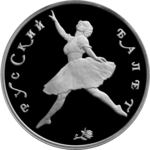 | ||||||||
| Geographical Series: The first Russian voyage around the world. English Embankment in St. Petersburg | |||||||||
| Date | Catalogue # | Value | Grading | Purity | Total weight, g | Platinum contents, at least, g | Diameter, mm | Thickness, mm | # pcs. |
| 28 April 1993 | 5318-0003 | 150 rubles | Proof | 999/1000 | 15.67 (± 0.11) | 15.55 | 28.60 (−0.25) | 1.5 (± 0.2) | 2500 |
| Obverse: center – the emblem of the Bank of Russia (two-headed eagle designed by I. Bilibin), bottom – symbol, purity and weight of platinum, "BANK OF RUSSIA" Reverse: ships Nadezhda and Neva and two boats. Background – houses of Russia's State Chancellor Count N.P. Rumyantsev in St. Petersburg on the English Embankment of the Neva River. Around it: "The first Russian voyage around the world 1803 • 1806" "English Embankment" Design: A.V. Baklanov Mint: Leningrad Mint (LMD). 240 indents on the rim. [8] |  | ||||||||
| Historical Series: Russia's Contribution to World Culture. I. Stravinsky | |||||||||
| Date | Catalogue # | Value | Grading | Purity | Total weight, g | Platinum contents, at least, g | Diameter, mm | Thickness, mm | # pcs. |
| 13 December 1993 | 5318-0004 | 150 rubles | Proof | 999/1000 | 15.67 (± 0.11) | 15.55 | 28.60 (−0.25) | 1.5 (± 0.2) | 3000 |
| Obverse: center – the emblem of the Bank of Russia (two-headed eagle designed by I. Bilibin), bottom – symbol, purity and weight of platinum, "BANK OF RUSSIA" Reverse: the image of Igor Stravinsky, background – a scene from the ballet "Petrushka", left – a lyre and a laurel branch, around: "RUSSIA AND WORLD CULTURE", "I. Stravinsky" Design: A.V. Baklanov Mint: Leningrad Mint (LMD) 240 indents on the rim. [9] | 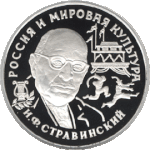 | ||||||||
| Series: Russian Ballet (25 rubles, 1994) | |||||||||
| Date | Catalogue # | Value | Grading | Purity | Total weight, g | Platinum contents, at least, g | Diameter, mm | Thickness, mm | # pcs. |
| 07.06.1994 | 5315-0002 | 25 rubles | Proof | 999/1000 | 3.198 (± 0.08) | 3.11 | 16.0 (−0.1) | 1.00 (± 0.15) | 900 |
| Obverse: two-headed eagle (designed by I. Bilibin), bottom – symbol, purity and weight of platinum, "BANK OF RUSSIA" Reverse: a dancing ballerina, around it: "RUSSIAN BALLET" Design: A.V. Baklanov Mint: Leningrad Mint (LMD) 111 indents on the rim. [10] |  | ||||||||
| Series: Russian Ballet (50 rubles, 1994) | |||||||||
| Date | Catalogue # | Value | Grading | Purity | Total weight, g | Platinum contents, at least, g | Diameter, mm | Thickness, mm | # pcs. |
| 07.06.1994 | 5316-0003 | 50 rubles | Proof | 999/1000 | 7.88 (± 0.09) | 7.78 | 20.0 (−0.15) | 1.60 (± 0.15) | 900 |
| Obverse: two-headed eagle (designed by I. Bilibin), bottom – symbol, purity and weight of platinum, "BANK OF RUSSIA" Reverse: a dancing ballerina, around it: "RUSSIAN BALLET" Design: A.V. Baklanov Mint: Leningrad Mint (LMD) 134 indents on the rim. [11] | 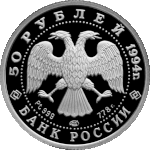 | ||||||||
| Series: Russian Ballet (150 rubles, 1994) | |||||||||
| Date | Catalogue # | Value | Grading | Purity | Total weight, g | Platinum contents, at least, g | Diameter, mm | Thickness, mm | # pcs. |
| 07.06.1994 | 5318-0005 | 150 rubles | Proof | 999/1000 | 15.67 (± 0.11) | 15.55 | 28.6 (−0.25) | 1.5 (± 0.2) | 900 |
| Obverse: two-headed eagle (designed by I. Bilibin), bottom – symbol, purity and weight of platinum, "BANK OF RUSSIA" Reverse: a dancing ballerina, around it: "RUSSIAN BALLET" Design: A.V. Baklanov Mint: Leningrad Mint (LMD). 240 indents on the rim. [12] | 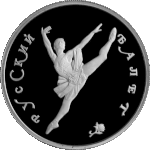 | ||||||||
| Geographical Series: First Russian Antarctic Expedition | |||||||||
| Date | Catalogue # | Value | Grading | Purity | Total weight, g | Platinum contents, at least, g | Diameter, mm | Thickness, mm | # pcs. |
| 06.09.1994 | 5318-0006 | 150 rubles | Proof | 999/1000 | 15.67 (± 0.11) | 15.55 | 28.6 (−0.25) | 1.5 (± 0.2) | 4000 |
| Obverse: two-headed eagle (designed by I. Bilibin), bottom – symbol, purity and weight of platinum, "BANK OF RUSSIA" Reverse: ships Vostok and Mirny, under them – a boat with rowers, penguins on an ice floe, around: "FIRST RUSSIAN ANTARCTIC EXPEDITION 1819–1821", "in Antarctic waters" Design: A.V. Baklanov Mint: Leningrad Mint (LMD) 240 indents on the rim. [13] |  | ||||||||
| Historical Series: Russia's Contribution to World Culture. Mikhail Vrubel | |||||||||
| Date | Catalogue # | Value | Grading | Purity | Total weight, g | Platinum contents, at least, g | Diameter, mm | Thickness, mm | # pcs. |
| 17 November 1994 | 5318-0007 | 150 rubles | Proof | 999/1000 | 15.67 (± 0.11) | 15.55 | 28.6 (−0.25) | 1.5 (± 0.2) | 3000 |
| Obverse: two-headed eagle (designed by I. Bilibin), bottom – symbol, purity and weight of platinum, "BANK OF RUSSIA" Reverse: self-portrait of Mikhail Vrubel, below – a palette and brushes, to the right – a fragment of his painting Demon Seated in a Garden, around: "RUSSIA AND WORLD CULTURE", "M. Vrubel" Design: A.V. Baklanov Mint: Leningrad Mint (LMD). 240 indents on the rim. [14] | 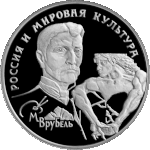 | ||||||||
| Series: Russian Ballet. Sleeping Beauty (25 rubles) | |||||||||
| Date | Catalogue # | Value | Grading | Purity | Total weight, g | Platinum contents, at least, g | Diameter, mm | Thickness, mm | # pcs. |
| 16 June 1995 | 5315-0003 | 25 rubles | Proof | 999/1000 | 3.198 (± 0.08) | 3.11 | 16.0 (−0.1) | 1.00 (± 0.15) | 900 |
| Obverse: center – the emblem of the Bank of Russia (two-headed eagle designed by I. Bilibin), bottom – symbol, purity and weight of platinum, "BANK OF RUSSIA" Reverse: in the center – a dancer, left to right in a circle – the inscription: "Sleeping Beauty". Design: A.V. Baklanov Mint: Saint Petersburg Mint (LMD) 111 indents on the rim. [15] | 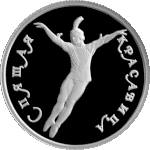 | ||||||||
| Series: Russian Ballet. Sleeping Beauty (50 rubles) | |||||||||
| Date | Catalogue # | Value | Grading | Purity | Total weight, g | Platinum contents, at least, g | Diameter, mm | Thickness, mm | # pcs. |
| 16 June 1995 | 5316-0004 | 50 rubles | Proof | 999/1000 | 7.88 (± 0.09) | 7.78 | 20.0 (−0.15) | 1.60 (± 0.15) | 900 |
| Obverse: center – the emblem of the Bank of Russia (two-headed eagle designed by I. Bilibin), bottom – symbol, purity and weight of platinum, "BANK OF RUSSIA" Reverse: a dancer, around him: "Sleeping Beauty" Design: A.V. Baklanov Mint: Saint Petersburg Mint (LMD) 134 indents on the rim. [16] |  | ||||||||
| Series: Russian Ballet. Sleeping Beauty (150 rubles) | |||||||||
| Date | Catalogue # | Value | Grading | Purity | Total weight, g | Platinum contents, at least, g | Diameter, mm | Thickness, mm | # pcs. |
| 16 June 1995 | 5318-0008 | 150 rubles | Proof | 999/1000 | 15.67 (± 0.11) | 15.55 | 22.60 (−0.25) | 1.5 (± 0.2) | 900 |
| Obverse: center – the emblem of the Bank of Russia (two-headed eagle designed by I. Bilibin), bottom – symbol, purity and weight of platinum, "BANK OF RUSSIA" Reverse: a dancer, around him: "Sleeping Beauty" Design: A.V. Baklanov Mint: Saint Petersburg Mint (LMD) 134 indents on the rim. [17] |  | ||||||||
| Historical Series: 1000 years of Russia. Alexander Nevsky | |||||||||
| Date | Catalogue # | Value | Grading | Purity | Total weight, g | Platinum contents, at least, g | Diameter, mm | Thickness, mm | # pcs. |
| 28 December 1995 | 5318-0009 | 150 rubles | Proof | 999/1000 | 15.55 (± 0.09) | 15.5 | 28.6 (−0.25) | 1.5 (± 0.2) | 3000 |
| Obverse: center – the emblem of the Bank of Russia (two-headed eagle designed by I. Bilibin), bottom – symbol, purity and weight of platinum, "BANK OF RUSSIA" Reverse: a fight between four Russian soldiers and a Swedish knight, around: "1000 YEARS OF RUSSIA · Alexander Nevsky", "BATTLE AT THE RIVER NEVA 1240" Design: A.V. Baklanov Mint: Saint Petersburg Mint (LMD). 240 indents on the rim. [18] |  | ||||||||
